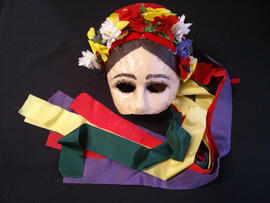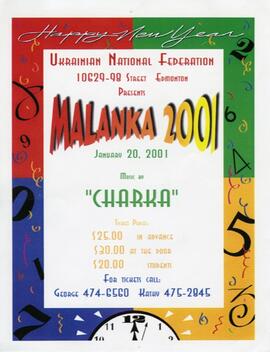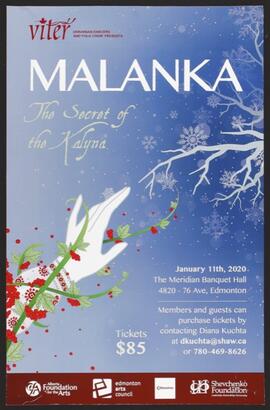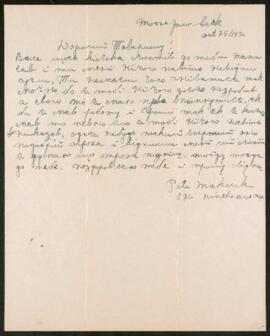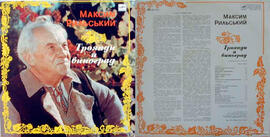The Faculty Club Malanka collection features memorabilia from the annual Malanka that took place at the University of Alberta Faculty Club between January 13, 1973 and January 1993. Included in the collection are masks, programs and other ephemera related to the festivities. There are 20 masks worn by mummers for Malanka ’89. The masks were designed and created in December of 1988 by Meron Sembaliuk with the assistance of his father Paul Sembaliuk. Each mask was handmade, either with papier-mâché or from articles found around the home. Meron organized a group of his friends to take on the various characters associated with the event. Included were: Mark Ferbey (Malanka), Ihor Hlushok (Sun God), Vasyl Maluzynsky (Vasyl/soldier), Shannon Hohol (soldier), and Terry Taciuk (thief). Other characters included: a Bear, a Goat, a Gypsy, a Star, an Old Man, a Bird.
There is also a letter from Dr. Manoly Lupul addressed to the Faculty Club administration outlining menu requirements, plus program menus which were designed and printed by Larisa Sembaliuk Cheladyn. Decorations for the event included unique rushnyky (ritual towels) that were designed and created by Paul Sembaliuk with the assistance of his wife Pat Sembaliuk, and his children Larisa and her husband Mich, sons Philip, Meron, Yuri and youngest daughter Andrea. This collection has the rushnyk specifically worn by Roman Onufrijchuk, the master of ceremonies for Malanka ’77.
The first Malanka at the Faculty Club was hosted by Dr. Metro Gulutsan. In the years that followed MC’s were invited from within the Edmonton Ukrainian Community and beyond including: Roman Onufrijchuk and Myroslav Kohut.
Sembaliuk familyby Ukrainian National Federation, Edmonton, Music by "Charka".
Poster advertising a Malanka performance by the Viter Ukrainian Dancers and Folk Choir. Event took place January 11, 2020.
The project consists of the materials collected for Nataliya Bezborodova's master thesis. The thesis traces Internet textual representations of the Maidan, a wide-scale protest movement that took place in 2013-2014 in Ukraine, and their function in identifying the opposing sides during the protests. These texts helped to formulate new narratives, articulate attitudes, and build relationships, create a sense of community within the protestors’ side, which had its impact on institutional changes of commemorative practices.
Facebook served as an important platform for the initial appeal, for coordination between the participants, for reflections, and for identification of the opposing sides during the protests. It was a key space for sharing emotions, personal stories, humor and expressive forms of protest, making allusions to known literary works, historical events and world public figures.
Exploring the types of narratives and their contribution in identifying the opposing sides, the work is focused on digital stories that illuminate elements not covered by the professional media coverage and official reports. It traces the diverse forms, topics and expressive devices in the narratives, and identifies the categories of lore (eyewitness narratives, (re)telling of stories, jokes, poetry, songs, etc.). It provides juxtaposition of the patterns found in the text with the main events of each specific day.
The thesis provides several chapters that focus on: (1) a review of the historical context of the events; (2) an analysis of the data with reference to all categories and topics, and the main findings; (3) the role of humor and expressive devices in releasing the tension of the conflict and in helping to formulate the attitudes within the protestors’ side; (4) evidence of the functions of personal stories as they build relationships, create a sense of community, and validate the participants’ experiences and the significance of the events from the protestors’ perspectives; (5) interpretation within this protest lore, and its impact on institutional changes of commemorative practices as in the example of the Nebesna Sotnia (Heavenly Hundred) narrative formation and its correlation to the repertoire of motifs and terms of the selected historical periods: the Cossack, the Ukrainian National Republic and World War II.
The study underlines the relevance of time and several patterns related to historical events, as Facebook posts immediately responded to the events occurring on the square and streets occupied by protestors, simultaneously with professional media outlets, and sometimes prior to them. These findings have important implications that go beyond the Ukrainian context in that they contribute to the further exploration of social networks functioning in relation to factual events.
